An Investigation of Critical Fire Weather Patterns: A Case Study †
Abstract
:1. Introduction
2. Materials and Methods
2.1. Study Area
2.2. Weather Patterns Investigation
2.3. Fire Detection
3. Results and Discussion
- Before the day of the initial fire ignition (as observed on October 10, 2019 at 18 UTC), a cut-off high blocking pattern built up over the Arabian Peninsula, with a ridge extending towards the lands of the eastern Mediterranean; simultaneously, a pressure trough with an open wave, which was located over north-eastern Libya (about 22° E longitude), progressed towards the east, which caused the open wave trough to deepen and distort the long wave ridge. Meanwhile, at the surface, there was a predominant high pressure system over the eastern Mediterranean, and a cold, dry front started to progress towards the eastern Mediterranean, causing atmospheric instability (with high values on the total totals index) and a cloudy sky, as shown in Figure 4, Figure 5 and Figure 6.
- The progressive open wave moved towards the eastern Mediterranean with a negative tilt on 11 October at 18 UTC, resulting in cold air advection and strengthening the surface high, building up the upper ridge with a notable extension in the cut-off high. Lebanon is located in the western side of the upper ridge. With this predominant surface high pressure system (Figure 5), the ridge aloft caused a subsidence of dry air (negative relative vorticity at 500 hPa and positive vertical velocity at 700 hPa), as shown in Figure 7 and Figure 8, which compresses the air in the lower atmosphere, thereby warming it. Simultaneously, the rising heat from the earth’s surface was trapped, causing the surface to heat. As the cold dry front passed through it, the Chouf region witnessed a lower temperature, cloudy skies with unstable conditions (with higher values of the total totals index) and gusty winds, as shown in Figure 4.
- The next day, on 12th October, at 18 UTC, the cold front passed, and the region experienced a cooler temperature, a slightly higher dew point temperature and mostly clear skies (Figure 4 and Figure 5). On the upper level, the trough deepened and progressed rapidly to the east with a positive tilt, and the shortwave moved to the western side of the upper ridge, causing it to flattening; meanwhile, the surface high still predominated over the region (see Figure 5.) This situation again led to warmer, drier and unstable conditions the next day due to the air subsidence over the eastern Mediterranean (negative relative vorticity at 500 hPa and positive vertical velocity at 700 hPa), as shown in Figure 5, Figure 7 and Figure 8.
- On 13 October, at 18 UTC, the deepened trough continued its progress towards the eastern Mediterranean, and the upper ridge built up again. Lebanon is located in the transition zone between the upper trough and the upper ridge (see Figure 5), which considered as a region of atmospheric instability due to the strong wind aloft moving downward producing low-level jets and surface daytime heating simultaneously, with particularly clear skies (see Figure 6). This led to the activation of the surface high and, consequently, warmer and drier conditions. Chouf district witnessed a higher temperature and a lower dew point, as shown in Figure 4. Moreover, with the availability of mid-level moisture, which is needed for the formation of convective clouds, thunder sparked the fire in the Chouf and dry fuels regions, as shown in Figure 9.
- On 14 October, at 18 UTC, as seen in Figure 5, both the upper patterns and the surface high weakened, enhancing surface Indian Monsoon at the surface level, and shifted towards the eastern Mediterranean. The surface heating continued, with lower dew point temperatures and unstable conditions (the total totals index reached more than 50 in Chouf), as shown in Figure 4. This situation represented the breakdown of the upper ridge, leading to the high-speed advection of dry wind towards the low levels, producing low-level jets associated with the surface front. Moreover, with the available moisture at the mid-levels, as shown in Figure 9, convective clouds developed, as explained above, producing thunderstorms with no rain over the Chouf district. This caused the lightning that we believe ignited the dry fuels (Figure 3). Consequently, rapid fire spread due to gusty surface winds in Chouf, which experienced temperatures higher than the average. In addition to the role of the wind in spreading the fires to farther regions, the thunder clouds that formed over other regions due to the rising current carried condensation nuclei (such as ash) emitted from the forest fires, igniting new fires in other forests.
- The situation at 18 UTC on 15 October continued, because the upper flow was “Zonal” and, as a result, the weather at the surface remained warmer and drier than average (see Figure 5), with the rising hot air from the forest fires reaching colder air at higher levels, with the available moisture (Figure 9), leading to the development of convective clouds, which in turn produced thunderstorms and lightning, with convective precipitation over Chouf of about 0.3 mm (Figure 4). The number of affected regions in the Chouf district increased, as shown in Figure 1.
- Although the Chouf district experienced rainfall on the previous day (Figure 1), which helped fight the fires, fires ignited again in many regions on 16 October, as seen in Figure 1, due to the unstable and warm conditions associated with the upper ridge’s breakdown; the upper trough moved towards the east with a positive tilt, resulting in low surface retrogression, activating the surface high and leading to cold air advection (Figure 5). As a result, the Chouf region experienced lower temperatures, with unstable conditions and gusty wind that triggered the ignition of further fires, as shown in Figure 4.
- On 17 October, at 18 UTC, the trough (open wave) developed to a cut-off low over the south-western Mediterranean Sea, and the upper ridge over the eastern Mediterranean Sea built up to a notable extent, while the high surface pressure strengthened. Consequently, Lebanon again lay under a blocked atmospheric system, which continued the warming but also forced the sea breeze towards the land (forming a cold front) due to the temperature gradient between the land and sea surfaces, as shown in Figure 4 and Figure 5. This situation resulted in the formation of convective clouds and less precipitation, particularly in high-terrain regions such as Chouf; therefore, the fires continued in many regions, but the situation became less critical, as seen in Figure 1.
4. Conclusions
Institutional Review Board Statement
Informed Consent Statement
Data Availability Statement
Acknowledgments
Conflicts of Interest
References
- Faour, G. Forest Fire Fighting in Lebanon Using Remote Sensing and Gis. 2004. Available online: https://www.researchgate.net/publication/310796768_FOREST_FIRE_FIGHTING_IN_LEBANON_USING_REMOTE_SENSING_AND_GIS (accessed on 25 September 2021).
- Flannigan, M.D.; Krawchuk, M.A.; De Groot, W.J.; Wotton, B.M.; Gowman, L.M. Implications of changing climate for global wildland fire. Int. J. Wildl. Fire 2009, 18, 483–507. [Google Scholar] [CrossRef]
- Werth, P.A.; Potter, B.E.; Clements, C.; Finney, M.A.; Goodrick, S.L.; Alexander, M.E.; Cruz, M.; Forthofer, J.A.; McAllister, S.S. Synthesis of knowledge of extreme fire behavior: Volume I for fire managers. Synth. Knowl. Extrem. Fire Behav. Vol. I Fire Manag. 2011, 854. [Google Scholar] [CrossRef]
- Dimitrakopoulos, A.; Papaioannou, K.K. Flammability Assessment of Mediterranean Forest Fuels. Fire Technol. 2001, 37, 143–152. [Google Scholar] [CrossRef]
- Chuvieco, E.; Aguado, I.; Dimitrakopoulos, A.P. Conversion of fuel moisture content values to ignition potential for integrated fire danger assessment. Can. J. For. Res. 2004, 34, 2284–2293. [Google Scholar] [CrossRef]
- Andela, N.; Van Der Werf, G.R. Recent trends in African fires driven by cropland expansion and El Niño to La Niña transition. Nat. Clim. Chang. 2014, 4, 791–795. [Google Scholar] [CrossRef]
- De Rigo, D.; Liberta, G.; Durrant, T.; Artes Vivancos, T.; San-Miguel-Ayanz, J. Forest Fire Danger Extremes in Europe under Climate Change: Variability and Uncertainty; EUR 28926 EN; Publications Office of the European Union: Luxembourg, 2017; ISBN 978-92-79-77046-3. JRC108974. [Google Scholar] [CrossRef]
- Moriondo, M.; Good, P.; Durão, R.; Bindi, M.; Giannakopoulos, C.; Corte-Real, J.A.M. Potential impact of climate change on fire risk in the Mediterranean area. Clim. Res. 2006, 31, 85–95. [Google Scholar] [CrossRef]
- Lucarini, V.; Gritsun, A. A new mathematical framework for atmospheric blocking events. Clim. Dyn. 2020, 54, 575–598. [Google Scholar] [CrossRef] [Green Version]
- Dong, L.; Mitra, C.; Greer, S.; Burt, E. The Dynamical Linkage of Atmospheric Blocking to Drought, Heatwave and Urban Heat Island in Southeastern US: A Multi-Scale Case Study. Atmosphere 2018, 9, 33. [Google Scholar] [CrossRef] [Green Version]
- Masoompour Samakosh, J.; Soltani, M.; Hanafi, A.; Azizi, G.H.; Mirzaei, E.; Ranjbar Saadat Abadi, A.; Yousefi, Y. The omega blocking condition and extreme rainfall in Northwestern Iran during 25–28 October 2008. J. Earth Space Phys. 2014, 40, 55–74. [Google Scholar] [CrossRef]
- Woollings, T.; Barriopedro, D.; Methven, J.; Son, S.-W.; Martius, O.; Harvey, B.; Sillmann, J.; Lupo, A.R.; Seneviratne, S. Blocking and its Response to Climate Change. Curr. Clim. Chang. Rep. 2018, 4, 287–300. [Google Scholar] [CrossRef] [Green Version]
- Efe, B.; Sezen, I.; Lupo, A.R.; Deniz, A. The relationship between atmospheric blocking and temperature anomalies in Turkey between 1977 and 2016. Int. J. Clim. 2020, 40, 1022–1037. [Google Scholar] [CrossRef]
- Rodrigues, M.; Gonzalez-Hidalgo, J.C.; Peña-Angulo, D.; Jiménez-Ruano, A. Identifying wildfire-prone atmospheric circulation weather types on mainland Spain. Agric. For. Meteorol. 2019, 264, 92–103. [Google Scholar] [CrossRef]
- Papagiannaki, K.; Giannaros, T.; Lykoudis, S.; Kotroni, V.; Lagouvardos, K. Weather-related thresholds for wildfire danger in a Mediterranean region: The case of Greece. Agric. For. Meteorol. 2020, 291, 108076. [Google Scholar] [CrossRef]
- Illera, P.; Fernández, A.; Delgado, J.A. Temporal evolution of the NDVI as an indicator of forest fire danger. Int. J. Remote. Sens. 1996, 17, 1093–1105. [Google Scholar] [CrossRef]
- Bugalho, M.D.L.; Camara, N.; Kogan, F. Study of Wildfire Environmental Conditions in Portugal with NOAA/NESDIS Satellite-Based Vegetation Health Index. J. Agric. Sci. Technol. B 2019, 9. [Google Scholar] [CrossRef]
- Zahran, E.S.M.M.; Shams, S.; Said, S.N.M.B.M.; Zahran, E.S.M.M.; Gadong, B.; Brunei-Muara, B.D. Validation of forest fire hotspot analysis in GIS using forest fire contributory factors. Syst. Rev. Pharm. 2020, 11, 249–255. [Google Scholar] [CrossRef]
- Mangiameli, M.; Mussumeci, G.; Cappello, A. Forest Fire Spreading Using Free and Open-Source GIS Technologies. Geomatics 2021, 1, 50–64. [Google Scholar] [CrossRef]
- Karouni, A.; Daya, B.; Bahlak, S. Forest fire prediction: A comparative study of applicability of fire weather indices for Lebanon. Glob. J. Technol. 2014, 5, 8–17. [Google Scholar]
- Mitri, G.; Nasrallah, G.; Gebrael, K.; Beshara, J.; Nehme, M. Assessment of post-fire land degradation risk in Lebanon’s 2019 fire affected areas using remote sensing and GIS. In Proceedings of the SPIE 11524, Eighth International Conference on Remote Sensing and Geoinformation of the Environment (RSCy2020), 115240T, Paphos, Cyprus, 26 August 2020. [Google Scholar] [CrossRef]
- Mitri, G.; Saba, S.; Nader, M.; McWethy, D. Developing Lebanon’s fire danger forecast. Int. J. Disaster Risk Reduct. 2017, 24, 332–339. [Google Scholar] [CrossRef]
- Hani, N. Sustainable Territorial Management and Action Plan Shouf Biosphere Reserve—Development Zone with Focus on Abandoned Terraces Lebanon. 2015. [Google Scholar]
- Jarvis, A.; Reuter, H.I.; Nelson, A.; Guevara, E. Hole-Filled Seamless SRTM Data V4, International Centre for Tropical Agriculture (CIAT). 2008. Available online: https://srtm.csi.cgiar.org (accessed on 25 September 2021).
- Hersbach, H.; Bell, B.; Berrisford, P.; Biavati, G.; Horányi, A.; Muñoz Sabater, J.; Nicolas, J.; Peubey, C.; Radu, R.; Rozum, I.; et al. ERA5 hourly data on pressure levels from 1979 to present. Reanal. Datasets 2019. [Google Scholar] [CrossRef]
- Hersbach, H.; Bell, B.; Berrisford, P.; Biavati, G.; Horányi, A.; Muñoz Sabater, J.; Nicolas, J.; Peubey, C.; Radu, R.; Rozum, I.; et al. ERA5 hourly data on single levels from 1979 to present. Copernic. Clim. Chang. Serv. (C3S) Clim. Data Store (CDS) 2018. [Google Scholar] [CrossRef]
- Schroeder, W.; Oliva, P.; Giglio, L.; Csiszar, I.A. The New VIIRS 375 m active fire detection data product: Algorithm description and initial assessment. Remote Sens. Environ. 2014, 143, 85–96. [Google Scholar] [CrossRef]
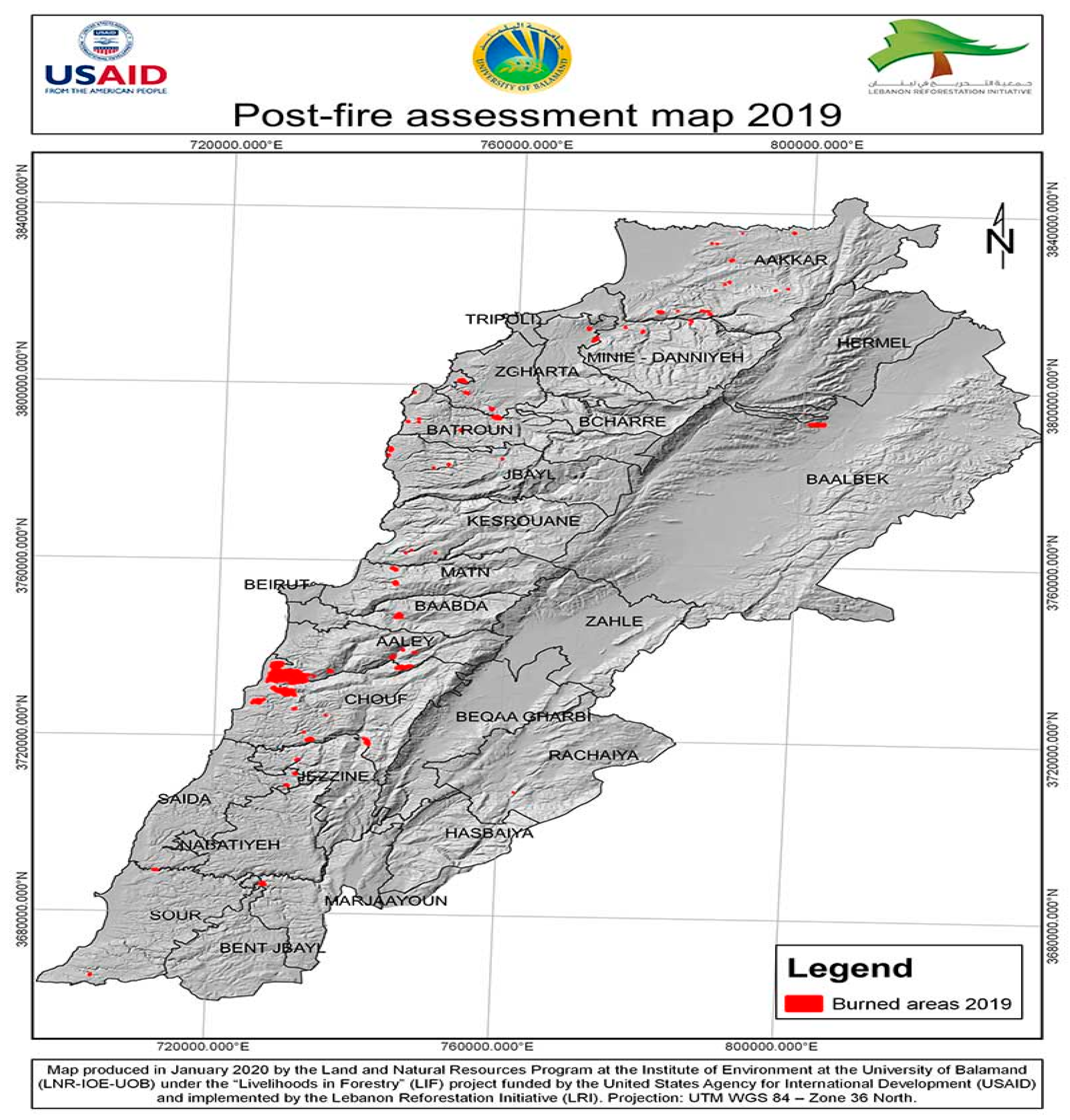
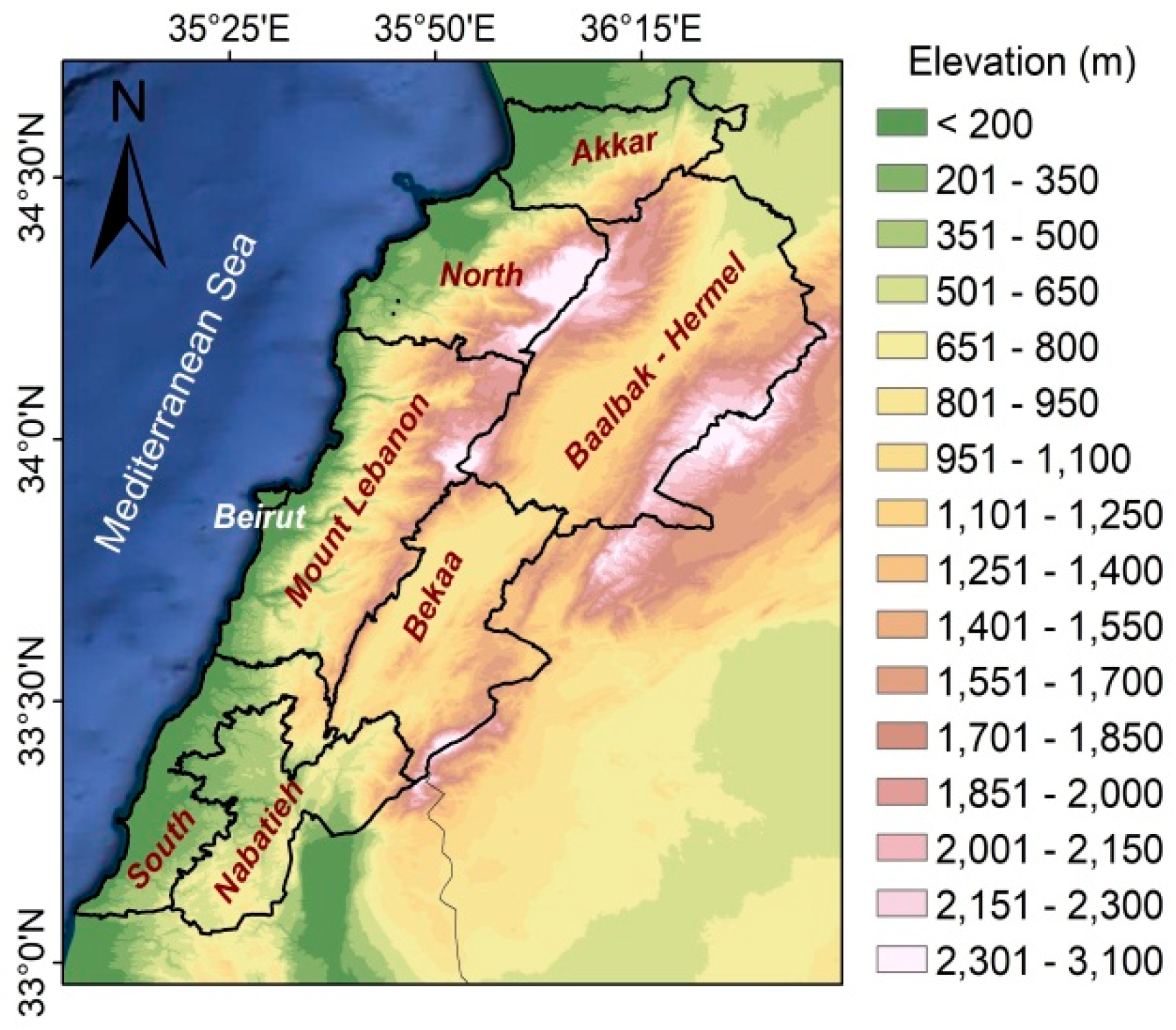
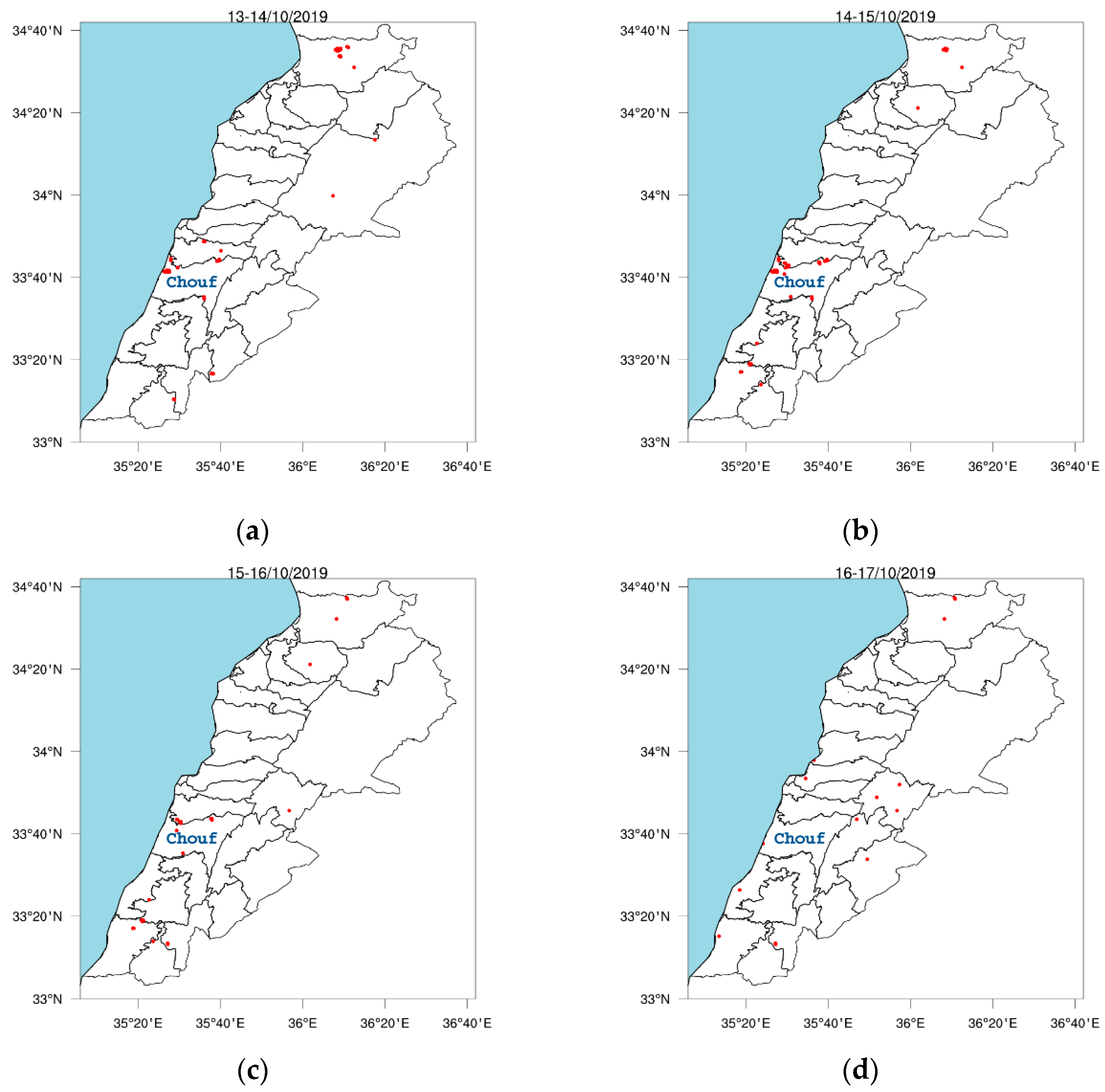
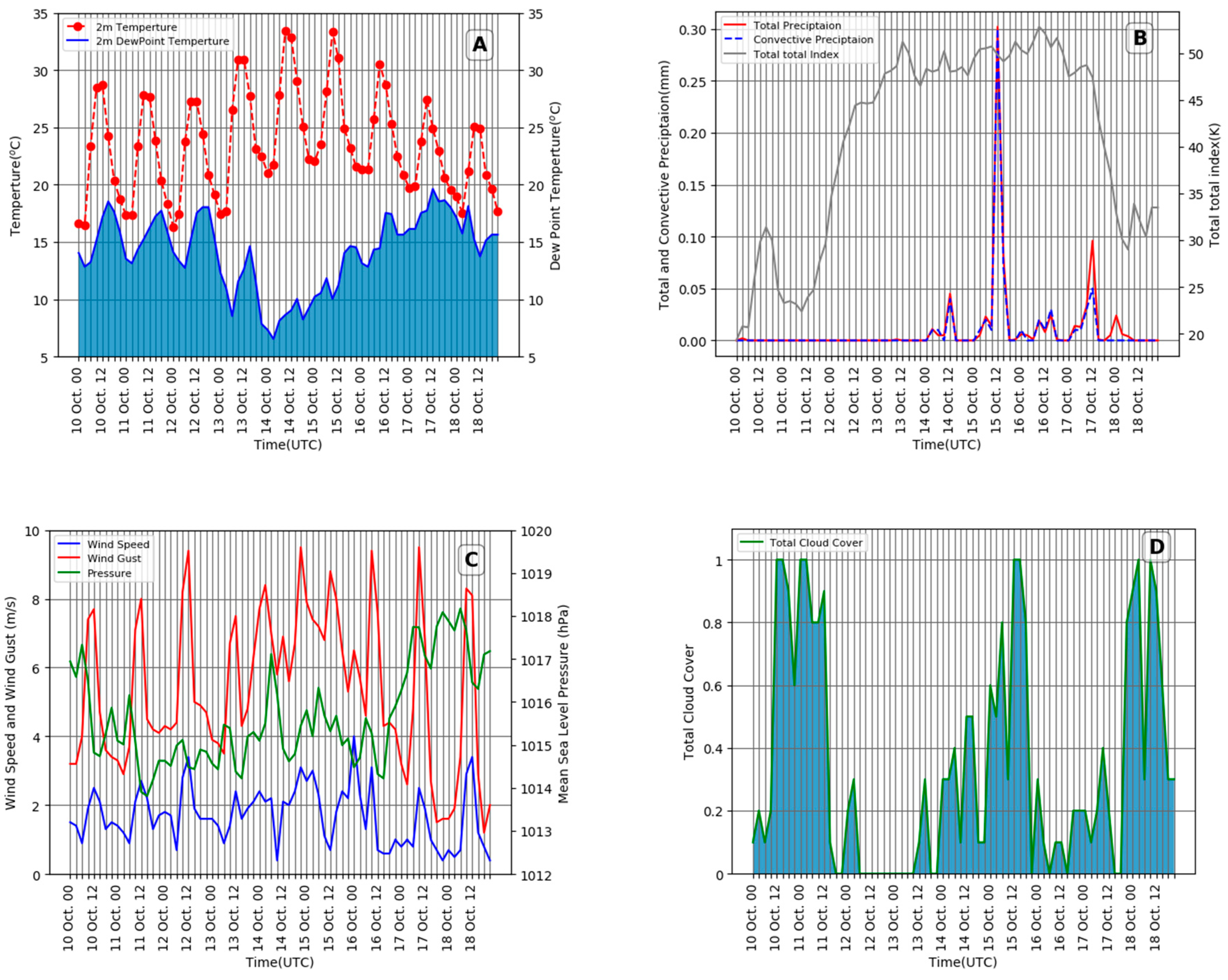
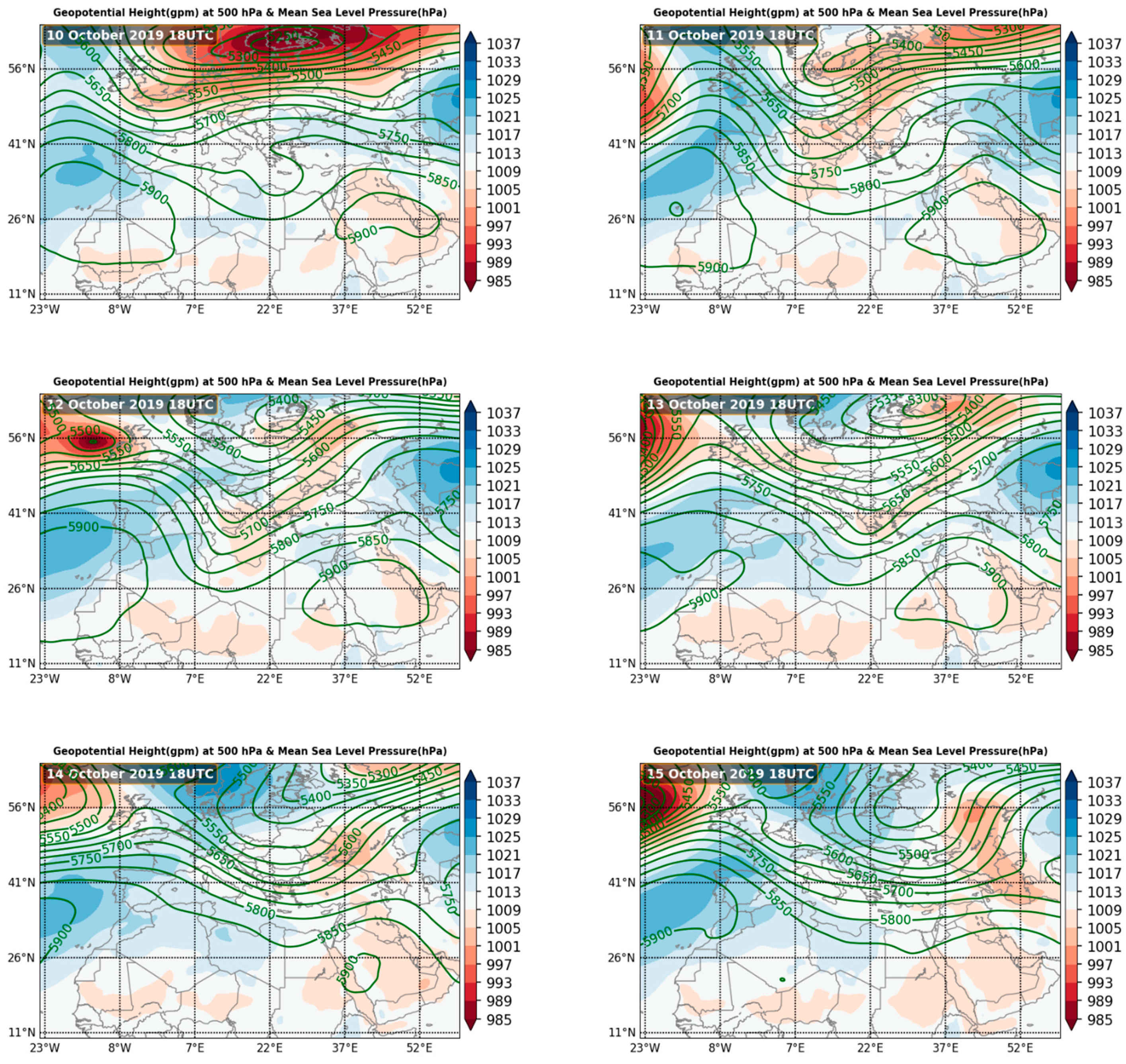



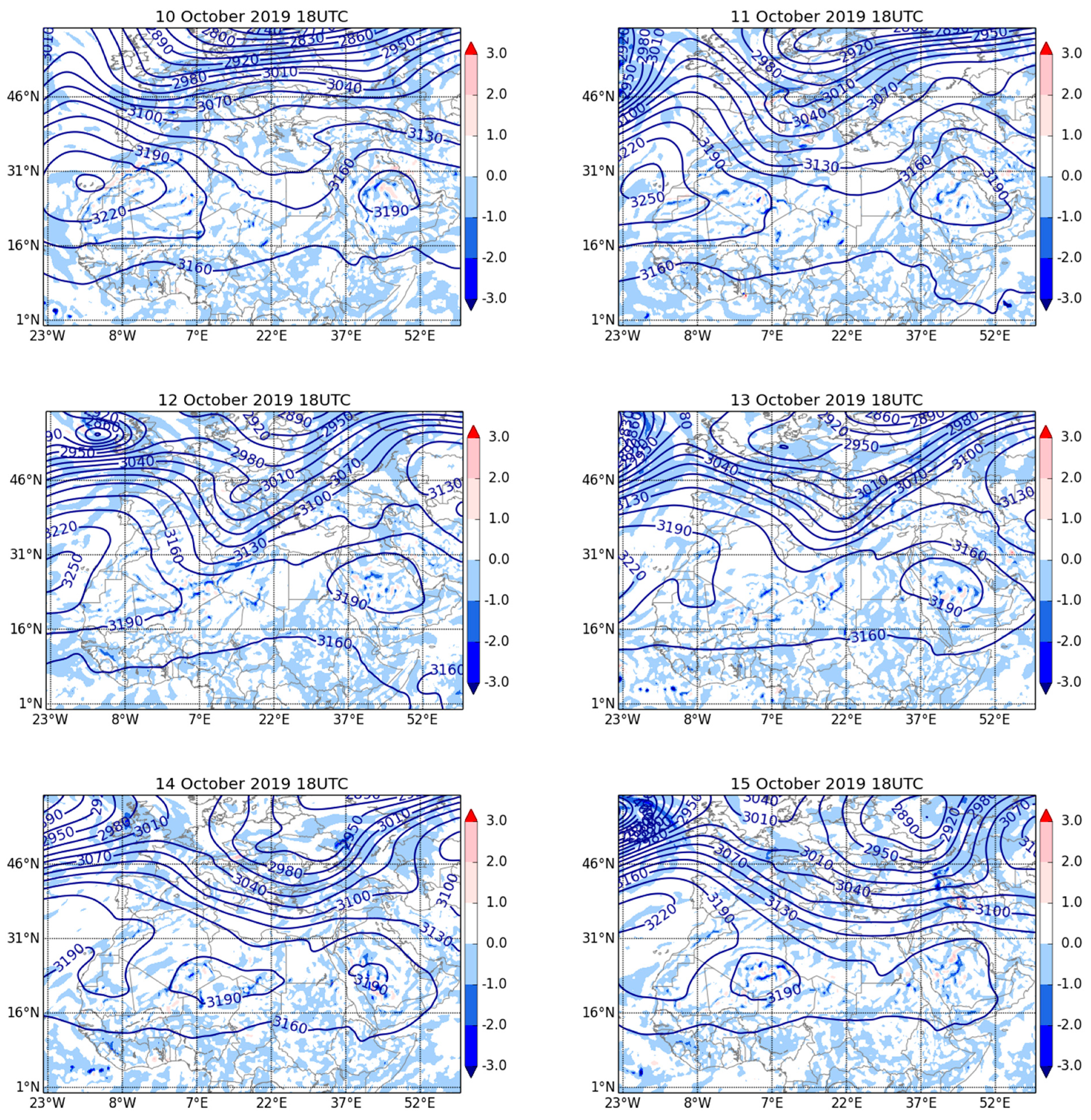



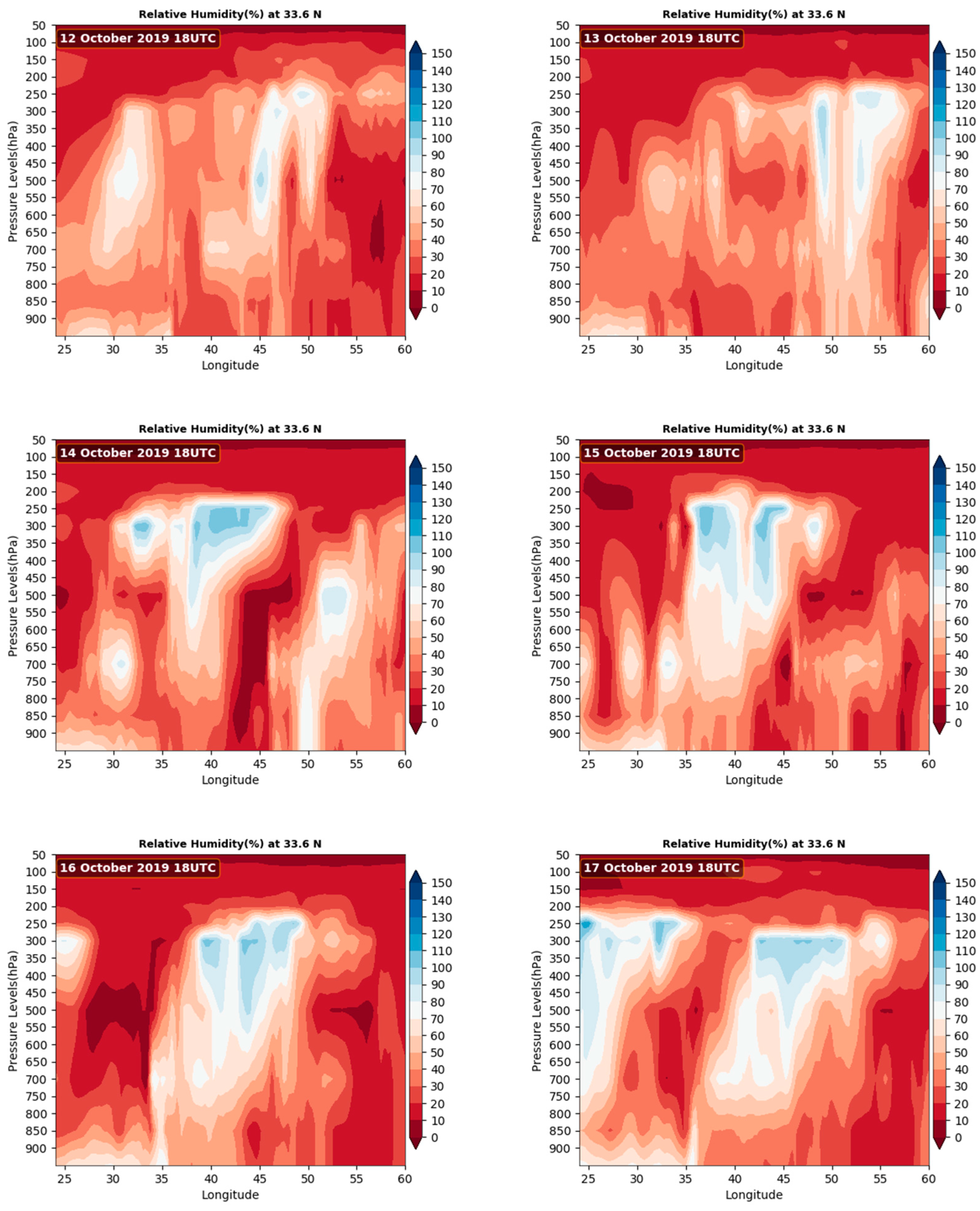
Publisher’s Note: MDPI stays neutral with regard to jurisdictional claims in published maps and institutional affiliations. |
© 2021 by the authors. Licensee MDPI, Basel, Switzerland. This article is an open access article distributed under the terms and conditions of the Creative Commons Attribution (CC BY) license (https://creativecommons.org/licenses/by/4.0/).
Share and Cite
Al-Dabbagh, S.; AL-Shouhani, H.; Hussein, N. An Investigation of Critical Fire Weather Patterns: A Case Study. Environ. Sci. Proc. 2021, 8, 37. https://doi.org/10.3390/ecas2021-10694
Al-Dabbagh S, AL-Shouhani H, Hussein N. An Investigation of Critical Fire Weather Patterns: A Case Study. Environmental Sciences Proceedings. 2021; 8(1):37. https://doi.org/10.3390/ecas2021-10694
Chicago/Turabian StyleAl-Dabbagh, Sama, Hadil AL-Shouhani, and Nabaa Hussein. 2021. "An Investigation of Critical Fire Weather Patterns: A Case Study" Environmental Sciences Proceedings 8, no. 1: 37. https://doi.org/10.3390/ecas2021-10694
APA StyleAl-Dabbagh, S., AL-Shouhani, H., & Hussein, N. (2021). An Investigation of Critical Fire Weather Patterns: A Case Study. Environmental Sciences Proceedings, 8(1), 37. https://doi.org/10.3390/ecas2021-10694






